
Unless you’re really rich, you would end up walking miles while traveling even when you’re not hiking whether you like it or not. And the only way it can be made fun is if your feet is comfortable. Good boots are the basic hygiene purchase you’ll have to make if you don’t want to be running around looking for new ones in a foreign country.
Good hiking boots can range from Rs. 1000 to Rs. 10,000 and the price alone doesn’t translate into quality. There are some features to look out for and test them personally before you commit to them. Also, I have found it cheaper to get good quality slightly expensive shoes over getting multiple cheaper shoes. Like the Quechua Novadry I used during my gap year every single day except beach days.
I got my pair of hiking boots on a sale and I couldn’t be happier with them. The Quechua shoes that are easily accessible in India ticked all my criteria for a hiking companion.
Why I Chose the Quechua Boots
I have large feet and I don’t buy leather. That cut some clutter for me.
I did multiple rounds of store visits to find the perfect fit and eventually found the Quechua Novadry that I felt comfortable in. It did seem heavy at the first and therefore I walked around in it for a few days while I was still in town and could choose to buy another pair before heaving for my big trip.
But with each passing day, I loved the shoes even more.
My main criteria was versatility as the overall weight of my backpack was crucial to my journey and I didn’t intend to travel with additional pair of shoes. These hiking boots were going to be my day shoes as well. Quecua shoes passed that test and I was very comfortable walking around towns in my boots especially because I ended up walking so much more than I usually do in India.
Features To Look For in Hiking Shoes
- Fit: One would spend hours walking in these shoes. It is the absolutely basic that one has to get right. It’s no fun walking in shoes that doesn’t fit or is not right giving blisters.
- Weight: Whether you’re walking in it or it goes in your backpack, it’s important to not get very heavy boots as walking seems tedious in them.
- Comfort: Find a fit that suits your feet. Ihave wide feet so I need shoes that are roomy.
- Versatility: For a long term traveller or light traveller, packing another pair of shoes is a big deal so choosing shoes that could pass as day shoes is important. I have used mine while commuting, for city walks, in clubs, and the last one was a snow hike.
- Durability: On my hike to Machu Picchu there was a guy whose shoe broke. All of us tried fixing it but it remained unfixable. It’s only on day 3 when we reached a small town that he was able to buy new pair of shoes. Not the most comfortable but better than broken ones. It’s terrible to have such once in a lifetime experience be ruined by a shoe.
- Water resistant: Water resistant shoes lets one waddle through light streams without worrying about wet shoes. Some boots are made of material that dries real quick which is also a big bonus.
- Ankle cover: While ankle cover is essential for tough terrain with higher possibility of ankle twists, I have been very happy with my hiking shoes that came without the ankle cover. The ankle cover is ideal for serious hikers and people who don’t have to worry to much about the pack weight.
How To Test Your Hiking Shoes
I have had store helps tell me many times how a shoe is a okay for me when I knew it was not. I have bought multiple shoes in my life as I only wear shoes on most days and therefore can now tell if the shoe is right for me or not.
- An easy test for hiking boots is to wear the shoe, hit the toe into floor or wall hard and see if it hurts. A goof shoe should ensure it provides enough cushion against stumbling into rocks.
- Check the sole for deep grooves. This allows for good grip in different terrrain.
- Soft sole is also good for finding grip and a good way to test is to knock against it and hear the noise. A soft surface produces mellow sound and a hard one produces loud noise.
- Hiking boots should have enough room for your feet to move a little bit for shock absorption also leaves space for woolen socks (Hiking socks are thicker than usual socks too).
How to care for your Hiking Shoes
The way we treat our boots would define how long they last and some easy ways to care for them are below:
- After a muddy hike, hang the shoes to get the dirt off as much as possible. I also like to dunk them in streams on the hike itself if I find any.
- Loosen the laces to take them off instead of slipping out of shoes directly.
- I like to carry an old toothbrush in my laundry essentials bag that I use to wash my shoes. It’s not to harsh and gets to the grooves easily.
Note: Hiking shoes don’t go in the washing machine. Hand wash them for longivity.